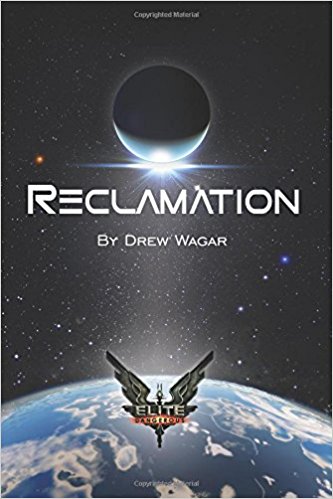This discussion between science fiction authors Drew Wagar and Stuart Aken at FantastiCon 2017 became a mini-masterclass in speculative writing, while also demonstrating there is no ‘right’ way to create genre narratives.

The two authors appear to have much in common. They both write politically-informed science fiction, although Stuart also writes in other genres and Drew has branched out into fantasy with his upcoming ‘Lords of Midnight’ adaptation.
However, Stuart likes recognizable, near-future stories and chose Mars as the setting for his ‘Generation Mars’ book series because it’s the planet we are most likely to get to next. Indeed, one of the challenges in writing the novels was that every day something new about Mars was discovered and it was hard to blend all this new knowledge into the story.

Drew likes Mars as a setting but finds it too close to home. It’s a well-explored world in science fiction and presents a challenge in finding something that hasn’t been done before. An amateur astronomer, Drew is fascinated by exoplanets in orbit around other stars. He found that the most common type of these stars is the red dwarf, and considered what would be required to support life on a planet near to one of them. For example, a red dwarf is older and cooler than our own sun, which means orbiting planets must be closer to the star to support life. These planets also appear to be tidally locked with one side constantly facing the sun, so it’s always day on one side of the world and always night on the other. Not only would there be no seasons, but also no time as we understand it. The author setting a story on such a planet would need to rewrite the rulebook on pretty much everything.
Stuart found opportunities for the yearned-for science fictional strangeness and originality in his Martian setting, not least because people’s conception of the planet is often ill-informed. For example, the Martian orbital period is twice that of the Earth’s. It means that time on Mars is different and that the ages of people there cease to have meaning; for example, a teenager would be only nine Martian years old. Interesting though these dynamics are, an author needs to ensure that the reader completely understands them for the narrative to have the desired effect.

Both authors are fans of post-apocalyptic fiction, although for different reasons. For Stuart, the appeal of the post-apocalyptic is the clean slate. However, conflict is built into the narrative because it’s intrinsic to the people who survive. Recent post-apocalypse survivors carry the same social conditioning that caused the disaster in the first place, while those existing further down the line are usually reduced to subsistence survival without the benefit of any historical perspective. Drew has a simpler appreciation of the genre; he just likes the cold, therapeutic romance of blowing everything up.

The main difference in approach between the two authors is method of composition. Drew is a plotter who details the entire structure of a novel including characters, plot and world-building before he starts writing the actual prose. Stuart writes more organically; he will start when he knows his characters and how the story ends. He doesn’t stop or look back during the process, which makes writing the book is as exciting as reading it. Stuart treats plot holes as a challenge and rewrites an entire book six or seven times before he starts editing.
Drew knows exactly what is happening in his books and when. He will let characters go off in interesting directions, but edits as he goes along. He hates plot holes and eradicates them before he begins.
Both authors take about a year to complete a novel.

Genre was a vexed question; for example, Drew maintains that science fiction can be enjoyable even if it is unrealistic; however, it should always be plausible. For Stuart, the science has to be right, even in fantasy; his particular irritant is the geologically impossible fantasy map. In science fiction, ‘The Martian’ was spoiled for him by the premise of a storm on Mars causing enough damage to wreck buildings. Difference atmospheric conditions on the red planet mean that a hurricane there would only travel at up to ten miles an hour, which is nowhere near enough to damage a building.
Drew took this idea further; his novel ‘Shadeward’ is science fiction, but because characters use swords it’s treated as fantasy. Meanwhile, ostensibly hard science fiction like the Elite Dangerous game relies on ideas like visible lasers, hyperspace and top speed for a spacecraft. While dramatic and intrinsic to the play, these ideas are so scientifically inaccurate as to be little different from the magic that informs classic fantasy.

Stuart writes without regard to genre and pigeonholes the book afterwards. He is rightly much more interested in character. A former professional photographer, he has a visual imagination and whenever he finds a picture of someone interesting he keeps it. He will then give the image history, family and ambitions to develop and make friends with the character.

His advice to those interested in becoming writers is to read Dorothea Brande’s ‘Becoming A Writer’ and doing all the exercises. Drew advises finding people who like the same things you do and not give up; becoming a writer takes a lot of practice and a long time. Stuart adds that it’s worth it; if you are a writer you can be anything you want: a rock, an animal, a god. It’s a brilliant way to spend your life.


An excellent, and amusing, piece Andrew. Thanks for sharing this, and providing evidence that you were definitely listening to what we tried to say!
LikeLiked by 1 person
Reblogged this on Stuart Aken and commented:
I had a great chat with Drew Wagar, whilst at Fantasticon 2017. This is a great account by one of those in the audience.
LikeLiked by 1 person